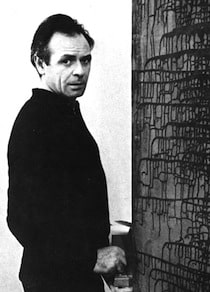Death of Marcos Grigorian (August 27, 2007)

Marcos Grigorian, an Iranian-Armenian artist, was a pioneer of Iranian modern art and later had a prolific career in the United States.
He was born on December 5, 1925, in Kropotkin (Krasnodar), in Russia. His family had fled from Kars after the Turkish occupation in October 1920. The family moved to Tabriz in 1930, where Grigorian’s mother died of appendicitis, and then to Tehran. After his father remarried in 1937, the family went to New Julfa and then returned to Tehran in 1940. He attended Alborz College and later Kamal-al-Molk Art School in 1948-1950.
After graduation, Gregorian studied at the Academy of Fine Arts in Rome between 1950 and 1954. He had several solo exhibitions in Rome and Paris. Then he returned to Iran and established the Galerie Esthétique, one of the first modern galleries in Tehran, helping organize exhibitions and publishing the work of many Iranian artists. A cosmopolitan and a multifaceted artist, Grigorian introduced the Iranian audience to the unconventional arts and innovative European sensibilities. He started collecting and promoting a form of folk art commonly known as coffeehouse painting. His appreciation for this fading practice inspired him to champion and publicize the last generation of masters of the genre.
He was married to Flora Adamian between 1955 and 1960. Their daughter Sabrina was born in Rome in 1956, when Grigorian participated in the Venice Biennale. He then returned to Tehran and was appointed as the Head of the Graphic Department at the Ministry of Culture and Art. In 1958, he organized the First Tehran Biennial, attempting to coin a modern tradition with ethnic flavor. Hel also participated as the Iranian delegate and an international jury member in the Venice Biennale.
In 1959 Gregorian completed a succession of enormous murals centering on the topic of the Holocaust. The impressive series of twelve 6×10 feet panels was later published in The Gate of Auschwitz (New York, 2002). During the same period, he started applying dirt to the center of his canvases. This became the starting point of his celebrated “Earthworks Series,” one that would focus on using earthen materials to symbolize man’s transient nature on earth.
In 1960 he started acting in Iranian films with the stage name of Gregory Mark. An energetic and talented performer, he played villains in eight movies until 1976, soon specializing in anti-hero roles and conspicuously contrarian characters. He moved to New York in 1962 and started a new phase in his artistic career. He was soon offered a teaching job at Minnetonka Center for the Arts (Minnesota), where he established the Universal Galleries. Two years later, he returned to New York, where he worked and lived until 1970, when he returned to Tehran and joined the Faculty of Fine Arts at Tehran University. In 1974 he formed the Independent Artists Group along with several Iranian artist and held several exhibits in the coming years. He earned various international awards during his career, including a silver medal at the New York International Art Exhibition in 1970.
Back to New York in 1980, Grigorian established Arshile Gorky Gallery, where he exhibited the works of Iranian and Armenian artists for several years. His daughter Sabrina Grigorian, a theater actress, passed away in 1986 after a heart attack at the age of 30. The tragedy shifted his artistic priorities. He immersed himself in his other passion, that of Armenian folk art and rug weaving. He made several trips to Armenia and in 1993 established the Sabrina Near East Museum of Yerevan, where he housed his own works and exquisite collection. During the last twenty years of his life, he organized several exhibits and weaving workshops in Armenia.
His early works, including the Auschwitz murals, presented in an expressive visual language of anxiety and despair, were potent images that forever remind the viewer of the cruelty of war and inevitability of death and decay. Years ahead of his time, his experimentation with earth, straw, and paint predated later pieces by modern American, European, and Japanese artists. Some of his exhibitions in Iran were criticized, but, on the other hand, he earned the appreciation of many for his modern artistic expressions and his innovative concepts. His later efforts for the revitalization of ethnic Armenian rug designs and weaving not only situated him within yet another local narrative, but uniquely erased the separating lines between art and craft, a characteristic of many artworks of the early twenty-first century.
Marcos Grigorian, who had moved to Armenia in the late 1990s, was assaulted and beaten by two masked robbers who had broken into his Yerevan home in early August 2007. He died of a heart attack on August 27, 2007, a day after leaving the hospital. He was buried in the local cemetery of Yerevan.
